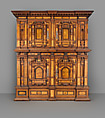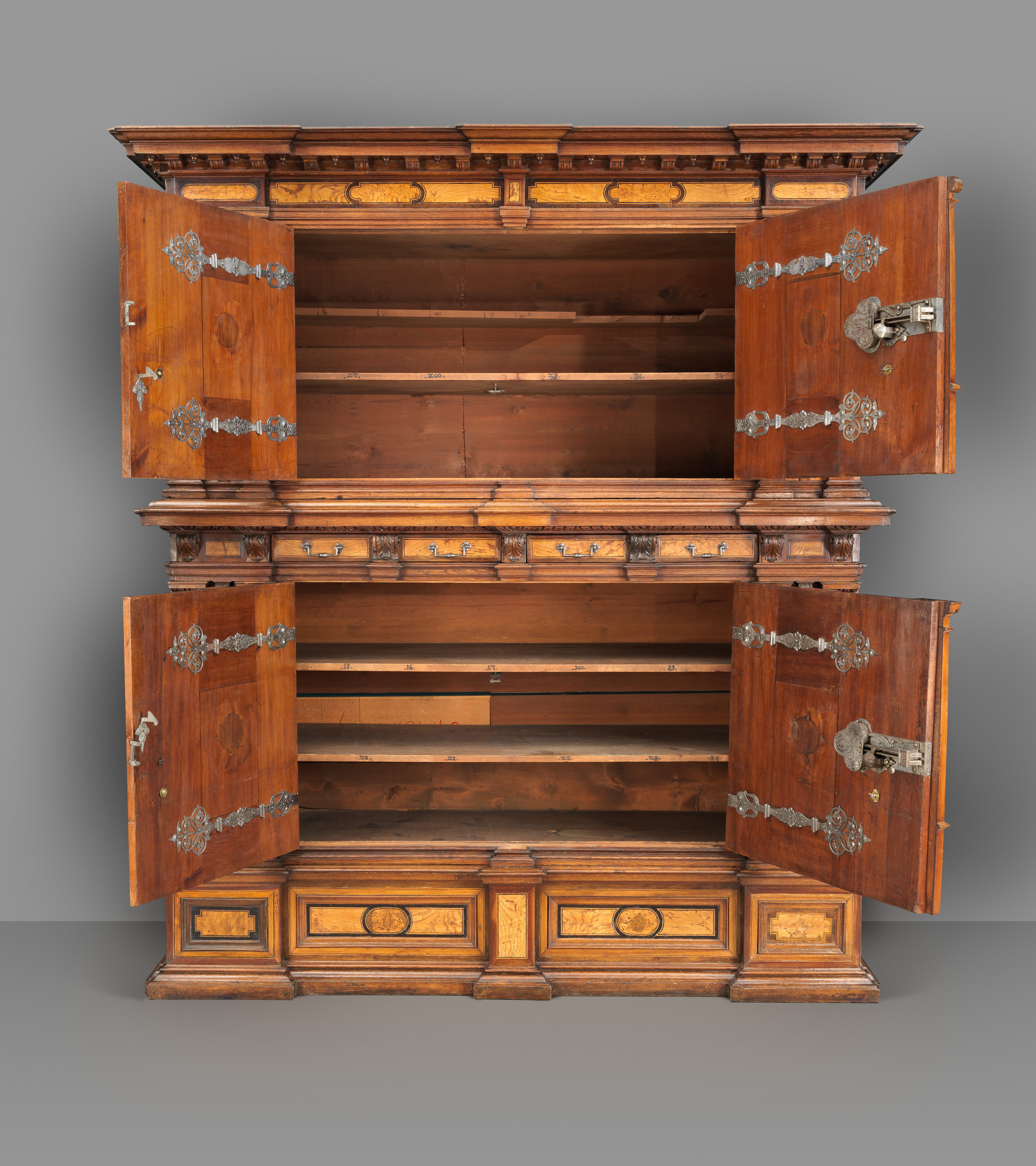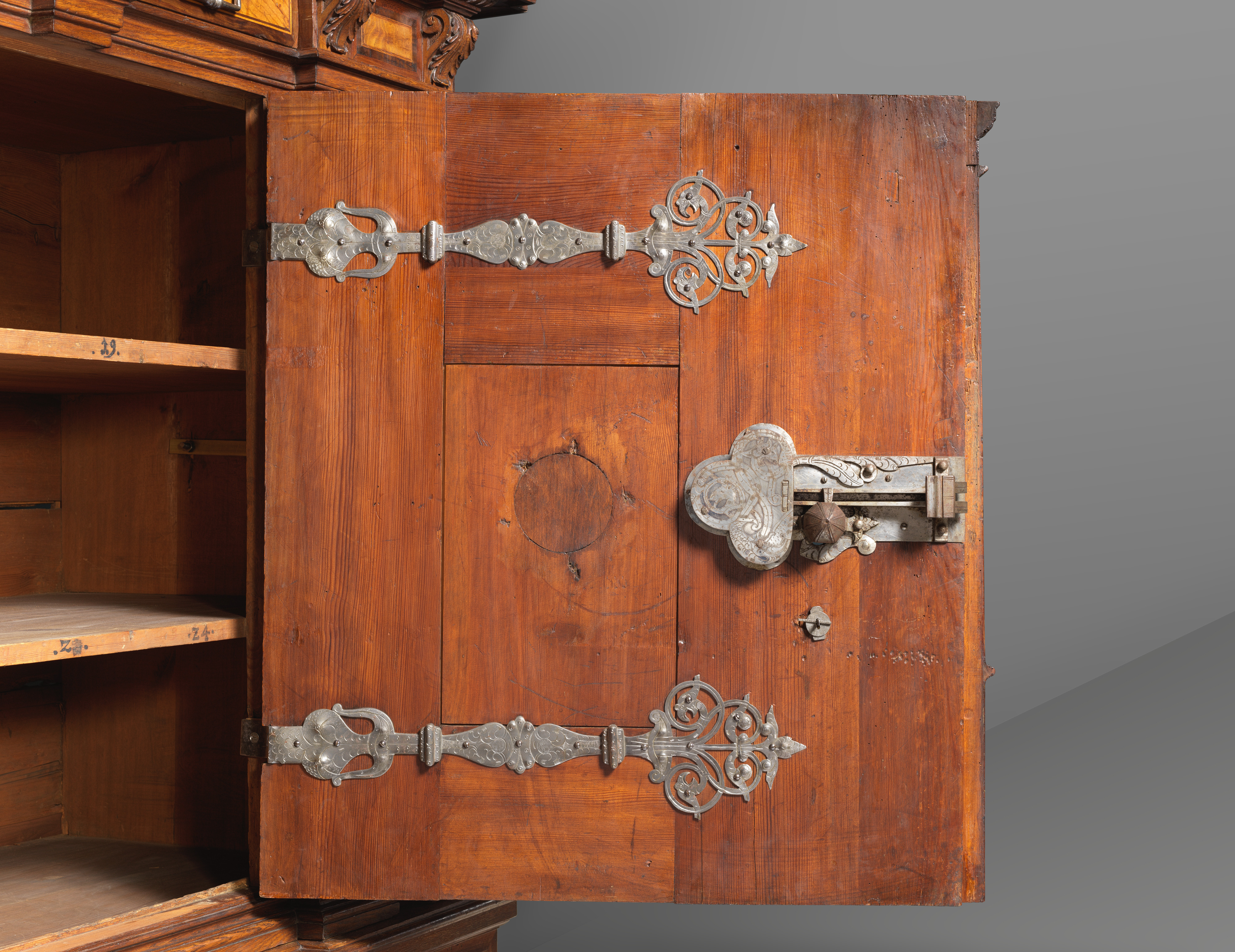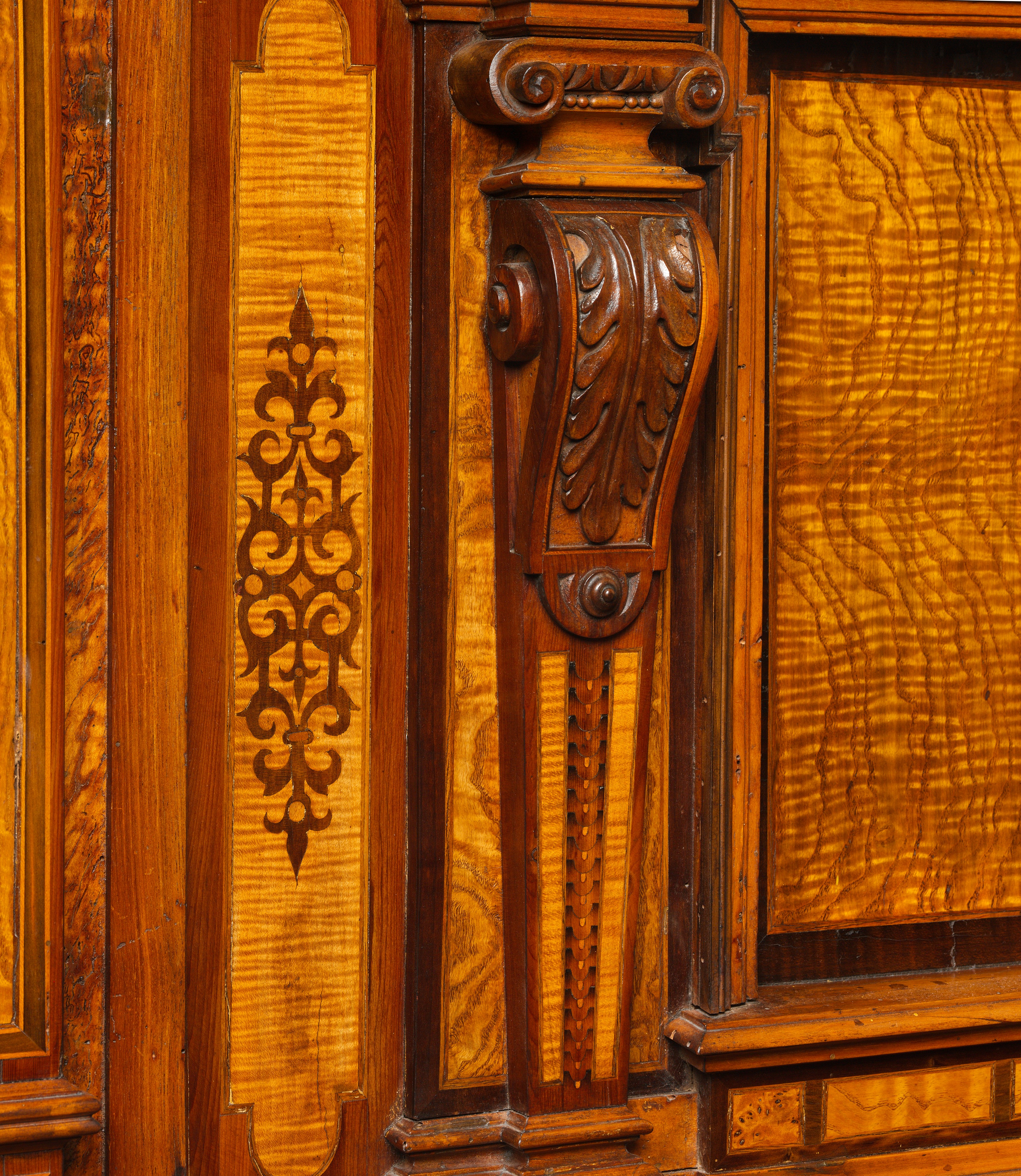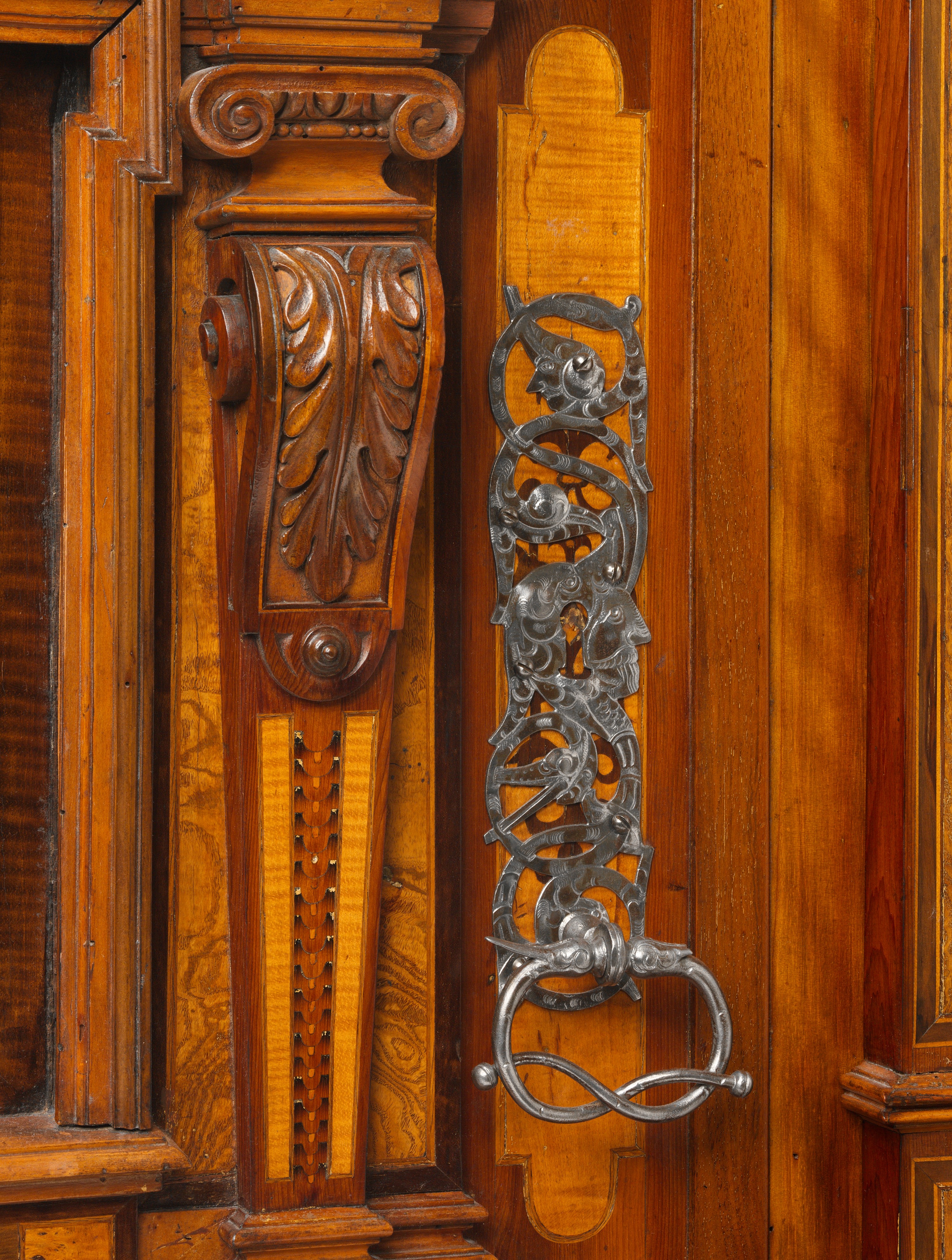Cabinet (Fassadenschrank)
During the sixteenth and seventeenth centuries in Central Europe, the term “woodworker” did not define a single trade. Instead, there were cabinetmakers and chairmakers, each represented by their own guild. The lathe-turned parts of wooden furniture could not be made in the shop but had to be bought from members of an independent turners’ guild and the hardware ordered from a master blacksmith. This complex system had been developed to protect guild members from outside competition and to guarantee them a minimum wage. Each master—that is, each qualified member of a guild—was allowed to employ only two journeymen and one or sometimes two apprentices. Only the artisans who worked for one of the many courts of the scattered German territorial states were exempt from these regulations.[1]
Apprentices in the extremely conservative cabinetmakers’ guild were required to create a masterpiece, or chef d’oeuvre, of highly complicated design in order to qualify as a master. The guilds in different German towns—from the free imperial cities of Augsburg and Nuremberg in southern Germany to the urban strongholds of the Hanseatic League in the north—had diverse requirements for masterpieces. Nor were all the candidates for mastership in a given guild treated equally in this respect. A “foreign” journeyman—and in the patchwork configuration of states in the Holy Roman Empire, that might mean a man born a stone’s throw from the boundary lines of the region under a guild’s control—often had to produce a more elaborate and costlier masterpiece than a local applicant for membership. A guild member’s son or son-in-law or the prospective husband of a master’s widow, all of whom were likely to acquire an already established workshop, were also assigned an easier task.[2] The cabinet piece not only had to demonstrate the design skills of the journeyman and his acquaintance with the architectural theory of the period[3]—for the practice of imitating architecture in furniture was widespread in Germany—but also had to show his mastery of joinery. Sometimes the assignment even included producing a simple structure, such as a window frame. The candidates had to invest money to buy the materials they needed and were unable to earn anything during the time they spent working on the piece. In most cases they were forced to sell their high-quality masterpiece immediately after presenting it to the aldermen of the guild, in order to pay city taxes, to cover entrance contributions to various guild funds, and to raise capital to establish their own business.
We do not know if the Museum’s splendid cupboard was a masterpiece; certainly it represents a tour de force of cabinetmaking. This type of cupboard with an architectural front (hence its German name, Fassadenschrank—literally, “facade cabinet”) became popular in Germany during the late Gothic period. The Museum’s example clearly reflects Italian Renaissance palace architecture of the sixteenth century. Certain carved elements on the pediments and in the niches and also the hardware ornaments indicate that it should be dated to the early seventeenth century, although its form in general would suggest the period between 1550 and 1575. It consists of a drawer-podium supporting a two-door cabinet, and at the top a hollow cornice. The form developed from the simple idea of placing two similar chests on top of each other to create an optical unit.[4] Characteristic details are the heavy wrought-iron handles, two on each side, which made it possible to dismantle the object quickly in case of fire.[5]
The cupboard’s majestic appearance derives from its balanced proportions, and its visual interest lies in architectural details such as the projecting and recessed components of the front and the use of woods of different colors and grain, which evoke the marble slabs on Renaissance facades.[6] When new, these woods must have offset each other to an even more striking effect. Unusual is the pretzel shape of the handles.
Large cupboards were often built to contain a bride’s linens. The long pine shelves of this one are marked with numbers (from one through thirty-one) to indicate exactly where rolls of fabric or folded items should be placed.[7]
This Fassadenschrank and a related cupboard were among the first pieces of Central European furniture to enter the Metropolitan Museum, and they remain the most important examples of their type in North American museums.[8]
[Wolfram Koeppe 2006]
Footnotes:
[1] Michael Stürmer. "'Bois des Indes' and the Economics of Luxury Furniture in the Time of David Roentgen." Burlington Magazine 120 (December 1978), p. 800; Michael Stürmer. Handwerk und höfische Kultur: Europäische Möbelkunst im 18. Jahrhundert, Munich, 1982; Michael Stürmer. Herbst des alten Handwerks: Meister, Gesellen und Obrigkeit im 18. Jahrhundert. Serie Piper 515. Munich, 1986; Christopher Wilk, ed. Western Furniture, 1350 to the Present Day, in the Victoria and Albert Museum, London. London, 1996, pp. 84, 98 (entries by Sarah Medlam; the two German cabinets she discusses are eighteenth-century; however, the guild situation had not changed since the late medieval period).
[2] Douglas Ash. "Gothic." In World Furniture: An Illustrated History, ed. Helena Hayward, pp. 26–24. New York, 1965, p. 34, fig. 86; Hans Huth. “Renaissance: Germany and Scandinavia.” In World Furniture: An Illustrated History, ed. Helena Hayward, pp. 47–52. New York, 1965, p. 48, fig. 136 (dated 1541); Peter Wilhelm Meister. “The Eighteenth Century: Germany.” In World Furniture: An Illustrated History, ed. Helena Hayward, New York, 1965, p. 146, fig. 572; Heinrich Kreisel. Die Kunst des deutschen Möbels: Möbel und Vertäfelungen des deutschen Sprachraums von den Anfängen bis zum Jugendstil. Vol. I, Von den Anfängen bis zum Hochbarock. Munich, 1968, pp. 74–76, 180–85, figs. 91, 93, 101, 142–51, 389, 390; Wolfram Koeppe. “Vergessene Meisterwerke deutscher Möbelkunst: Die Meisterstücke der Breslauer Schreinerzunft im 18. Jahrhundert.” Kunst & Antiquitäten, 1991, no. 4, pp. 38–45; Wolfram Koeppe. Die Lemmers-Danforth-Sammlung Wetzlar: Europäische Wohnkultur aus Renaissance und Barock. Heidelberg, 1992, pp. 118, 157–59, 162–64, 168, 192–94, nos. M52, M88, M92, M97, color ills. pp. 190, 192, 242; and John Morley. The History of Furniture: Twenty-five Centuries of Style and Design in the Western Tradition. Boston, 1999, p. 74, fig. 129.
[3] The ten-part treatise De Architectura (after 17 B.C.) by the Roman architect Vitruvius Pollio was very influential. It had been reissued in Latin in 1485 in Rome by Giovanni Sculpicio. One of the best-known editions north of the Alps was Sebastiano Serlio’s treatise Regole generali di architettura sopra le cinque maniere de gli edifici published in 1537 in Venice and translated into German in 1542; Hubertus Günther. Deutsche Architekturtheorie zwischen Gotik und Renaissance. With contributions by Michael Bode et al. Darmstadt, 1988. Another important German translation of Vitruvius’s De Architectura, with added illustrations, was Vitruvius Teutsch by Walther Hermann Ryff (Rivius) of Nuremberg (ca. 1500–after 1545), published in 1548. Ryff, who added his own commentary, dedicated the work “to all artistic craftsmen, foremen, stonecutters, builders, headgear makers and gunsmiths,…painters, sculptors, goldsmiths, cabinetmakers, and all who have to use the compass and the guiding ruler in an artistic manner.” Thus, Ryff intended his publication not for a small circle of humanist connoisseurs but for practicing craftsmen, including the makers of fine furniture; see Ingrid Dann. “Walther Ryff.” In Hubertus Günther. Deutsche Architekturtheorie zwischen Gotik und Renaissance. With contributions by Michael Bode et al. Darmstadt, 1988, pp. 79–88, especially p. 81.
[4] Franz Windisch-Graetz. Möbel Europas von der Romanik bis zur Spätgotik. Munich, 1982, p. 265, no. 238; Wolfram Koeppe. Die Lemmers-Danforth-Sammlung Wetzlar: Europäische Wohnkultur aus Renaissance und Barock. Heidelberg, 1992, pp. 157–59, no. M88, color ill. p. 190.
[5] For similar cabinets, see Peter Wilhelm Meister and Hermann Jedding, eds. Das schöne Möbel im Laufe der Jahrhunderte. Heidelberg, 1958, fig. 101; Margrit Bauer, Peter Märker, and Annaliese Ohm. Europäische Möbel von der Gotik bis zum Jugendstil. Museum für Kunsthandwerk. Frankfurt am Main, 1976, figs. 17, 18 (the captions to these two illustrations are in reverse positions); Franz Windisch-Graetz. Möbel Europas: Renaissance und Manierismus, vom 15. Jahrhundert bis in die erste Hälfte des 17. Jahrhunderts. Munich, 1983, pp. 356–57, nos. 213, 294; and Wolfram Koeppe. Die Lemmers-Danforth-Sammlung Wetzlar: Europäische Wohnkultur aus Renaissance und Barock. Heidelberg, 1992, pp. 117–18, no. M52, color ill. p. 183.
[6] Erik Forssman. Säule und Ornament: Studien zum Problem des Manierismus in den nordischen Säulenbüchern und Vorlageblättern des 16. und 17. Jahrhunderts. Acta Universitatis Stockholmiensis. Stockholm Studies in History of Art I. Stockholm, 1956, pp. 39ff.
[7] The cabinet was restored in 1993–94 by John Canonico, Conservator, Department of Objects Conservation, Metropolitan Museum. Damaged shelves in the upper compartment have not been replaced.
[8] The accession number of the related cabinet is 05.22.1.
Due to rights restrictions, this image cannot be enlarged, viewed at full screen, or downloaded.
This artwork is meant to be viewed from right to left. Scroll left to view more.
